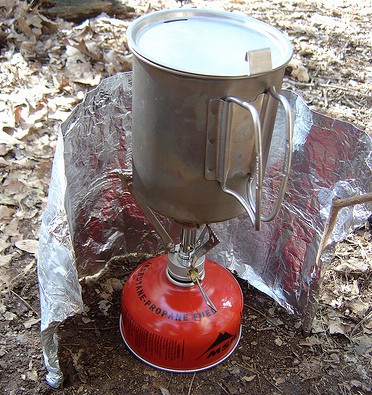Canister stoves typically see a decline in performance in cold weather. During burning the fuel inside the canister evaporates, causing the canister to cool. Moisture in the air will condense or freeze on the outside of the canister further chilling the gas inside the canister. The temperature inside the canister can drop to a point where the liquid fuel inside the canister won’t evaporate appropriately.

When to use a canister stove.
Before discussing ways to combat cold weather’s effect on a canister stove let’s define what we mean by cold. In sub-zero temperatures, while the first 2/3 of the propane/butane blend canister will deliver as expected, the canister may need to be warmed to keep the flame going. At temperatures above 15, isobutane offers a more consistent delivery of fuel, without the need to keep the canister warm during the final 1/3 of its canister life. Above 40 degrees F and the issue is a moot one. Summary, in conditions that are single digits or less use a white gas stove.
Type of fuel.
The type of fuel canister is important as they are not all the same. Most canister stoves have some combination of n-Butane, isobutane, and propane. Here are the relative percentages for popular canisters:
Primus: 50 % n-butane, 25 % isobutane , 25 % propane
Peak1: 70% n-butane, 0% isobutane, 30% propane
MSR IsoPro: 0% n-butane, 80% isobutane, 20% propane
Snow Peak: 0% n-butane, 85% isobutane, 15% propane
Why is this mixture information important? Without the fuel in the canister being vaporized, there is no pressure to feed fuel into the jet. These fuel components all vaporize at different temperatures.
n-Butane vaporizes at 31 degrees F
Isobutane vaporizes at 11 degrees F
Propane vaporizes at -43 degrees F
When you use your stove at or below 31 degrees is the n-butane will cease to vaporize and all the propane and/or isobutane will vaporize instead and that will burn first, leaving just cold liquid n-butane in the cartridge. Likewise, if you use your stove at or below 11 degrees, the propane will be the first to go leaving only isobutane and butane in a liquid form with no more pressure. Generally, you want less n-butane and more propane for cold temperatures.
Increasing efficiency.
The easiest way to increase the efficiency of the canister is to start off with a warm canister. Keep them deep in your pack or jacket or in your sleeping bag so they start off warm. You can heat the canister by using a chemical hand warmer.
Setting a canister in a pool of water, it can be as little as an inch, it keeps the frost from condensing on the canister and chilling the gas inside.
If your stove has a preheat stage, meaning the fuel line loops through the flame to vaporize the fuel before it goes through the jet, you can invert the canister so the stove functions as a liquid feed. Light the stove with the canister upright. Then turn the canister over and stabilize it. This is beneficial because the propane (which will vaporize in all but the worst conditions on earth) will stay above the liquid butane and isobutane, pushing it down through the fuel line into the stove. You don’t want to turn the stove on very much, as it will behave very differently with the canister upside down. Basically with the valve just cracked you will get a full roar, and you don’t have as much flame adjustment as you do with the canister upright. When you shut it off it will burn for a few seconds until all of the gas is out of the fuel line.
Windscreens
Use a windscreen and keep a lid on whatever you are cooking. A windscreen should deflect the wind from both the stove and the cooking pot. It should not totally enclose the stove: there must be room for air to get in and allow for excess heat dissipation. You can lay your pack or a sleeping pad on it’s side as a wind block or use aluminum foil.
The windscreen should reach a bit above the top of the stove and up the side of the pot,. If you are using a large pot, as is normal, there should be a slight clearance between the pot and the windscreen. Don’t enclose the canister and flame together. If you make the gap between the windshield and the pot too small and have a minimal gap between the ends of the windscreen, you will be bottling up very hot air. This might or might not cause combustion problems, but will almost certainly transfer a lot of heat into the fuel tank or cartridge if it is inside the windshield, which could then get too hot.

How hot is too hot?
How can you tell how hot you can safely allow your canister to get? All gas canisters must be able to take at least 122 F without any damage at all in order to pass the relevant European and American Standards, but it is best to keep the canister below ‘hand temperature’, which is about 86 F. Warm is OK, ‘hot’ is not. Typically, your hand can touch something below 113 F without it getting an ‘ouch’ response.
Put your hand on the canister. If it feels cold let it warm up a little bit. If it feels cool to mildly warm, that’s good, but keep an eye on it. If it starts to feel hot or above a comfortable hand temperature, take action to limit the thermal feedback such as adding a shield. If the canister feels too hot to touch comfortably take action fast and shut the stove down at once.
If you hear the stove is starting to roar a bit, check the canister temperature. The roar suggests that the internal pressure is getting too high.
Follow our occasional Tweets @WinterCampers
SHARE

